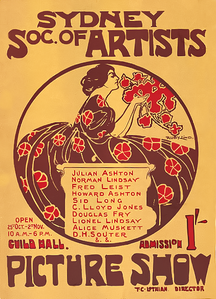|
Ruby Lindsay
Ruby Lindsay (20 March 1885 – 12 March 1919)[1] was an Australian illustrator and painter, sister of Norman Lindsay and Percy Lindsay. BiographyLindsay was born in Creswick, Victoria,[1] the seventh child and second daughter of Robert and Jane Lindsay, and lived in Melbourne from the age of 16 with her brother Percy while studying at the National Gallery of Victoria School. Lindsay drew occasionally for The Bulletin and illustrated William Moore's Studio Sketches (1906) and designed posters and certificates including the Certificate First Class and a prize-winning poster for the Australian Exhibition of Women’s Work, in 1907.[2] As an illustrator she went by several names; signing her work as "Ruby Lyne", "Ruby Lyn", "Ruby Lind", and once as "Ruby Ramsbottom".[3] She was described by art critic Haldane MacFall as "the most remarkable woman in the pen-line now living" in his History of Painting.[4] On 30 September 1909 she married Will Dyson and then left for England with him and her brother Norman Lindsay.[5] Her brother Lionel had earlier married Will's sister Jean.[6] Ruby and Will had one daughter, Betty (1911–1956). In 1912, she contributed illustrations to the book Epigrams of Eve by child welfare advocate and journalist Sophie Irene Loeb. After World War I she visited relations in Ireland and died during the Spanish flu pandemic. Lindsay is buried in the same grave as her husband in Hendon Cemetery, London. Her name on the headstone is shown as "Ruby Lind". Gallery
Books
See alsoReferences
External linksWikimedia Commons has media related to Ruby Lindsay.
|
||||||||||||||
Portal di Ensiklopedia Dunia




